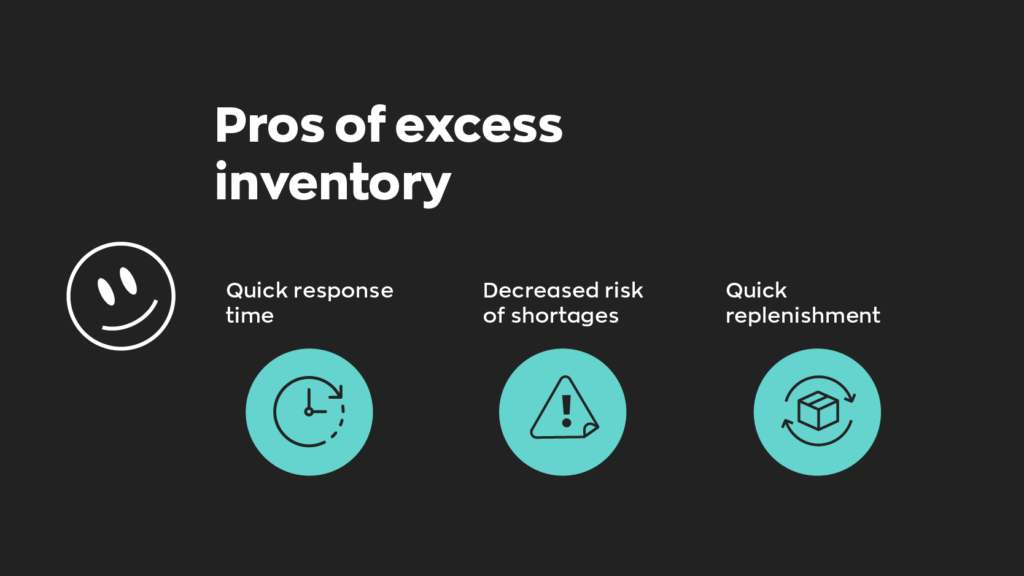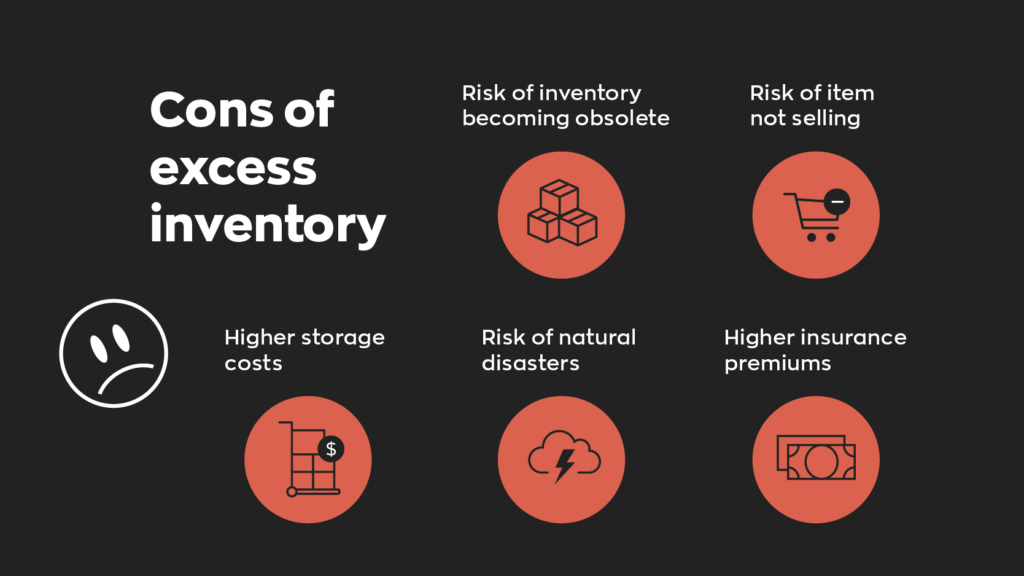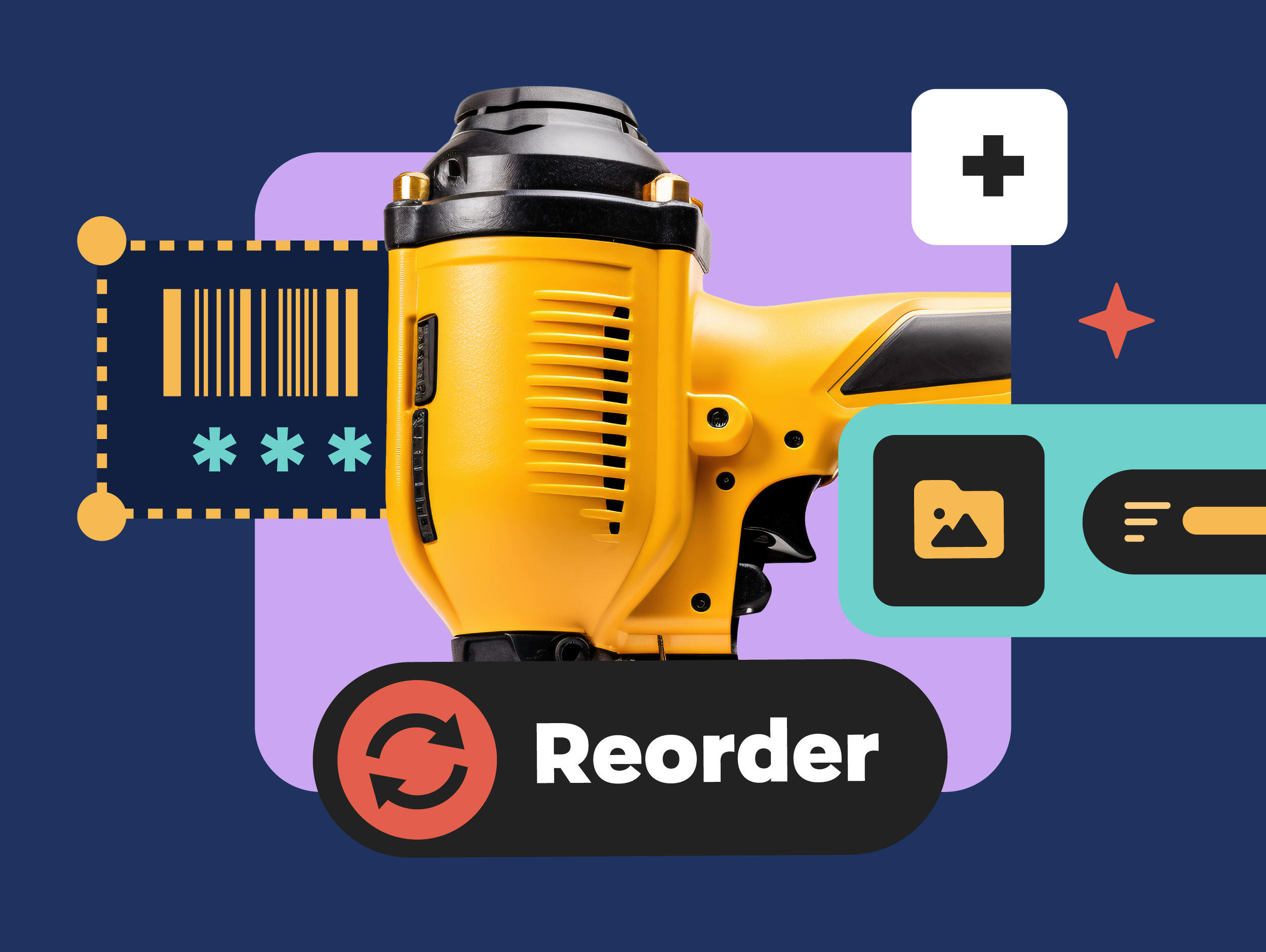Key takeaways
- Excess inventory is a surplus of goods or products that exceeds foreseeable customer demand.
- When evaluating excess inventory, it’s important to exclude safety stock since it serves a distinct purpose and, therefore, is not considered surplus.
- Common causes of excess inventory include poor forecasting, a shift in customer demand, and poor inventory management, among others.
- While you generally should avoid excess inventory, it does come with both pros and cons.
- Some pros of excess inventory are quicker response time, decreased risks of shortages, and quicker replenishment.
- Some of the cons of excess inventory are tied-up cash flow, risk of obsolescence, and increased storage costs.
- Finding a healthy balance of inventory levels is crucial for businesses to optimize their operations.
With any goods-based business, inventory is the primary source of revenue. So, it’s essential to be smart when holding inventory. It can be tempting to keep excess inventory to ensure you’ll always be able to provide for your customers. But is carrying excess inventory really the best idea? How do you know when you have too much inventory on hand? What happens to excess inventory if you’re unable to sell it?
This article will help you understand the different aspects of inventory control, including some general rules of thumb.
It’s important to note that when we talk about excess inventory, we aren’t talking about safety stock. Since safety stock serves a distinct purpose, it isn’t considered surplus. We have a blog dedicated to safety stock and its relation to reorder points if you want to learn more. Just know that safety stock isn’t considered surplus inventory because it serves a distinct purpose.
So, without further ado, let’s discuss excess inventory!
What is excess inventory?
Excess inventory refers to any surplus of goods or products that surpasses customers’ immediate or anticipated demand. Therefore, any inventory you have that is not utilized or sold within a reasonable timeframe is considered excess inventory.
As mentioned above, excess inventory does not include safety stock. Safety stock is when you deliberately carry too much inventory on hand to protect your business from unknown factors. It’s for those ‘just-in-case’ moments, like unexpected demand or delays from your supplier.
Common causes of excess inventory
Inventory control is all about reaching a delicate balance in your inventory levels. After all, holding inventory for extended periods will eat into your margins. On the other hand, carrying too little could result in stockouts. Your inventory levels will fluctuate for several reasons, and sometimes, you may find yourself with excess inventory. Some common causes of excess inventory are:
- Poor demand forecasting
- Shift in demand
- Lack of coordination between departments
- Inadequate inventory system
- Product life cycle changes
- Seasonality
- Logistical Complications
In order to balance your stock levels, many businesses use things like inventory turnover ratio, but these formulas aren’t flawless, and you could still find yourself holding a surplus of stock.
So why is too much inventory bad? Well, the truth is sometimes it’s not. Sometimes, having too much inventory on hand can be a good thing. Let’s examine all the pros and cons of carrying excess inventory.
Pros to holding excess inventory
Quicker response time
You can quickly fill all customer orders as soon as they arrive—no need to worry about waiting for your stock to arrive. If you can’t ship an order quickly, you’ll lose those valued customers.
Decreased risk of shortages
By keeping stock on hand, you can guarantee that you will always have a particular item. You’ll also have less to worry about if you discontinue a product. If there is a shift in demand for a product, you’ll be able to meet (or even beat) the competition, which means you’ll be able to sell your excess inventory at an excellent price.
Quick replenishment
By keeping excess inventory, you can work to make sure that your shelves are always full. It’ll ensure your store always has a neat and tidy appearance.

Cons of holding excess inventory
Tying up Cash flow
When your business is holding inventory, you tie up capital, which will risk slowing down your cash flow. This means you’ll have less money to do other things, such as marketing efforts or procuring other products.
Risk of inventory becoming obsolete
The value and quality of your product decrease the longer you keep it in stock. You have to make it a priority to sell your inventory while it’s new to the market. Smartphones, for example, are updated almost every six months. So, you have to sell your stock before new versions arrive. Otherwise, you might have to sell them at a discounted price because it has become outdated or obsolete. Similarly, if you sell perishable goods, you’ll need to sell them at a lower price as it gets closer to the expiration date. Generally, a forced sale is never good and could cause a loss for your business.
Risk of an item not selling
You may have decided to keep excess inventory but then realized you misjudged what will and will not sell. In doing so, you could end up with too much inventory on hand that people don’t want to purchase. Again, you might have to sell at a steep discount or below cost to move the inventory out of your warehouse.
Higher storage costs
Excess inventory means extra storage space. Additional space also means extra costs, and since you have to include those extra costs in your price, you might lose to competition because your price is too high. Even if you have your own warehouse, you would still have extra maintenance costs and risk needing more space for new items. Proper inventory control is all about optimized warehouse space.
Risk of natural disasters
Any type of stock is always at risk of being destroyed or damaged by fires, floods, or other natural disasters. However, having less of it in excess would incur more minor losses should these natural disasters happen.
Higher insurance premiums
The insurance you will pay for items will be directly related to the capital cost of the products you store. The more inventory you keep and the longer you keep it, the more insurance you pay. It’s really that simple!

How do you improve your inventory control?
When weighing the pros and cons of holding excess inventory, you must compare your carrying costs against the potential cost of stockouts to your business. Carrying costs would include the cost of capital, insurance, storage fees, material handling, administration, and any other fees you may incur for holding onto inventory that is taking up real estate in your warehouse.
While it is true that there are different ways to get around many of the cons on the list, it is essential to keep in mind these very real issues that present themselves when dealing with too much inventory on hand.
As mentioned, in many cases, keeping additional inventory in stock is a good thing. You have probably found that having enough of a hot-selling product is a constant problem. Rather than come up short when a customer is eager to buy, keeping a reserve in the back is wise. Empty shelves are never a good look for a retailer, so it’s best to keep them filled whenever possible. You can do this by planning your safety stock levels to account for unexpected fluctuations in your inventory levels.
One way to help ensure that you always have good inventory control is to use software designed to manage your warehouse. For example, inFlow will alert you when your stock hits a certain point and allow you to create a purchase order with a few clicks. If you’re looking for inventory barcode software, inFlow has that covered too! Read our Ultimate Barcoding Guide to learn about barcodes, including how to start barcoding your business.






The content was very helpful. Keep it up on informing us these things TJ McCue.
Thanks alot
Is helpful to exam
Article Feedback*the article was helpful could gou make one on stock out costs.thank you
Does your company, or one that you are familiar with, ever store excess products? If so, explain why.
Lovely website!!!!
Helped me a lot with my school work!
I hope you guys take over the rubbish wikipedia, they are very bad. You guys are actually amazing, would definitely recommend to everyone. 10/10!!!! 🙂 🙂 🙂 🙂
Love Yassir!
This was a really insightful post! I never realized how excess inventory could be a double-edged sword. It’s interesting to see both the potential cost savings and the risks involved. I particularly appreciated the examples you provided; they really helped to illustrate your points. Looking forward to more posts like this!
Hey Vimeo,
I’m glad to hear you enjoyed the article. We love helping people like you with their inventory troubles 🙂
Cheers,
Jared